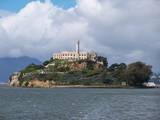 
|
San Francisco Sights to See
Alcatraz Prison
|
 |
As difficult as it can be to comprehend, for
a structure that served the purpose that made it famous for not quite
30 years, Alcatraz still remains today an enduring monument to a bygone era.
By the time it first came into use as a U.S. Federal Penitentiary
in 1934 Prohibition had already ended. (The amendment of the U.S. Constitution to outlaw the sale of alcoholic beverages was passed in January 1919,
but was repealed in December 1933.) Nonetheless, Alcatraz' most famous figure from that activity, Al Capone
had already ended. (The amendment of the U.S. Constitution to outlaw the sale of alcoholic beverages was passed in January 1919,
but was repealed in December 1933.) Nonetheless, Alcatraz' most famous figure from that activity, Al Capone , took up "residence" from 1934 to
1939, when he was released. , took up "residence" from 1934 to
1939, when he was released.
Arriving not long after Capone's release was another prisoner, almost as well known. In prison for manslaughter, Robert Stroud was transferred from Leavenworth in 1942.
Nicknamed the 'Birdman of Alcatraz ', he wrote several books both before
and during his incarceration. (The nickname was popularized by a best-selling book and subsequent film starring Burt Lancaster.) Ironically, he did keep birds at Leavenworth,
but kept no birds at Alcatraz. ', he wrote several books both before
and during his incarceration. (The nickname was popularized by a best-selling book and subsequent film starring Burt Lancaster.) Ironically, he did keep birds at Leavenworth,
but kept no birds at Alcatraz.
Still, apart from its famous, and infamous, inmates, the prison offered several reasons for its own fame, or infamy.
 Long an isolated site, the island a few miles off the coast of San Francisco
housed a military prison beginning in 1907. Almost inevitably, in the
early 1930s Federal prison system officials decided to use the location to hold its most
hardened criminal detainees. It was thought that the dangerous, cold,
and rapidly moving currents off the coast would discourage escape attempts. Long an isolated site, the island a few miles off the coast of San Francisco
housed a military prison beginning in 1907. Almost inevitably, in the
early 1930s Federal prison system officials decided to use the location to hold its most
hardened criminal detainees. It was thought that the dangerous, cold,
and rapidly moving currents off the coast would discourage escape attempts.
Even so, many still tried to escape "The
Rock".. Evidence of the results - among them bullet holes
and blood stains - can still be seen on some of the walls.
Guards were hired that were thought to be much less subject to bribes.
When Capone arrived and attempted it, he was thrown into solitary
confinement. Prisoners were entitled to food, clothing, shelter and
medical attention.
All else was a privilege to be earned through good behavior.
After its eventual closure in 1963 (among other problems, the facility
was twice as expensive to maintain as other prisons), the island was mostly
unused for the next 10 years. Then, in 1973, Alcatraz was
incorporated into the burgeoning system of National Parks
and began a new incarnation as a tourist attraction. Since then, over
14 million visitors have taken the 10-minute boat ride from Pier 41 to see 'The Rock'.
The tour includes an introductory video which explains the history of
the prison and the island. At the site are books, audio guides and
other items. Tour guides then direct the group up the hill to the
cellhouse. The audio guide contains sessions in which former
correctional officers and inmates
describe what life was like at the prison. Tour guides provide
interesting and enlightening commentary while visitors explore Al
Capone's cell and
other areas.
Touring after dark is an especially good method for getting a sense of
the dismal living conditions. Since San Francisco stays light in the summer long
after the tour leaves, this can only be done in winter. However,
conditions then are particularly unpleasant, so decide in advance how much
authenticity you want to experience.
Both the boat rides to and from, as well as the island itself can be
quite windy and cold, so dress appropriately. Of course, San Francisco
can get quite warm in the summer, as well. Take care to dress in layers.
Between the ride and the tour a great deal of standing and walking is involved, and
not all of it is on level ground, so be prepared for some exercise.
Tickets generally sell out, sometimes weeks in advance. Plan ahead by
purchasing from Alcatraz
Tickets at www.alcatraztickets.com
(link opens new window) or call
the number listed on the site.
Click Here to learn more about San Francisco.
Sitemap
Cities of the World
|




had already ended. (The amendment of the U.S. Constitution to outlaw the sale of alcoholic beverages was passed in January 1919, but was repealed in December 1933.) Nonetheless, Alcatraz' most famous figure from that activity, Al Capone
, took up "residence" from 1934 to 1939, when he was released.
', he wrote several books both before and during his incarceration. (The nickname was popularized by a best-selling book and subsequent film starring Burt Lancaster.) Ironically, he did keep birds at Leavenworth, but kept no birds at Alcatraz.
Long an isolated site, the island a few miles off the coast of San Francisco housed a military prison beginning in 1907. Almost inevitably, in the early 1930s Federal prison system officials decided to use the location to hold its most hardened criminal detainees. It was thought that the dangerous, cold, and rapidly moving currents off the coast would discourage escape attempts.
